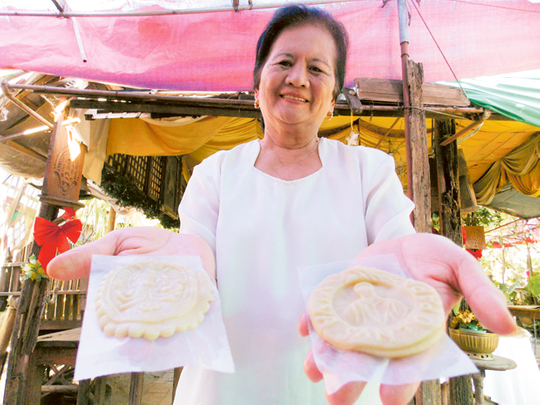
Manila: The infectious fever whipped up by Pope Francis in the Philippines from January 15 to 19 has continued to inspire a baker in central Luzon. She has been receiving hundreds of orders from clients nationwide for her new product: Pope Francis biscuits.
“I could not attend the Mass of Pope Francis at the Luneta Park in Manila [on January 18]. I watched him on TV while baking oblong biscuits that bear his smiling face. Orders for them keep coming,” says Lillian Mercado Lising-Borromeo, 77, whose house on Jose Abad Santos Street, Pampanga, 100 kilometres north of Manila, hosts a culinary heritage tour.
The Pope Francis biscuit is not an ordinary product, and its maker comes from a long line of bakers.
Last October, Borromeo decided to make Pope Francis biscuits using a recipe that her family had used for five generations to make popular San Nicolas biscuits.
Adorned with the image of San Nicolas de Tolentino who was introduced by the Catholic Augustinian order as a baker’s saint, the age-old baked product began as a culinary legacy of Spanish colonialism from 1521 to 1898, Born in Italy’s Pontano, de Tolentino (also known as Nicholas Gurruti, 1246-1305), was canonised by Augustinian Pope Eugene IV in 1446. Made of Uraru flour, the roundish cookie is praised for its thin, layered wafers with a hint of lime and coconut milk (or water buffalo’s milk), which melt in the mouth.
“Last year, I was the only one among the commercial bakers of the San Nicolas biscuits in Pampanga who thought of making Pope Francis biscuits. Arnel, a wood carver, made seven molds of the pope’s face for me. I chose the best one to start the project,” says Borromeo. The kneaded dough for the San Nicolas and Pope Francis biscuits are separately shaped in their respective carved wooden molds before they are baked.
In the past, rich families in Pampanga, the country’s culinary capital, cultivated plantations of uraru root crops, which workers tediously processed into flour to make the San Nicolas biscuits once a year — for gifts and family consumption only.
“My great, great grandmother Andrea Hizon [born in 1730] baked the rare biscuits only on special occasions, a tradition strictly followed by my great grandmother Paula David [born in 1930],” recalls Borromeo.
“At the time, religious rituals surrounded the culinary activities of rich families. Parish priests of the 440-year-old Augustinian Church (founded in 1575) in Macabebe, Pampanga blessed newly baked San Nicolas biscuits during Saint Nicholas day, on September 10. Old families believed this reinforced the biscuits’ healing power. Kept in cookie jars, the rare baked products were never sold,” she adds.
Explaining the mysterious healing power of the San Nicolas biscuits, Borromeo quotes her father Dr Anastacio Lising who claimed that cookies in jars develop a mold similar to the source of penicillin, an antibiotic. The late historian-writer Alejandro Roces gave the same explanation about the mysterious and delicious age-old Philippine biscuit.
The legendary belief that the San Nicolas biscuit is a holy baked product has added an aura of mystery to the newly concocted Pope Francis biscuits. In time, the Pope Francis biscuits will inherit layers of mystique attained by the San Nicolas biscuits for 500 years, food historians predict.
“I started baking San Nicolas biscuits in commercial volume in 1977, 38 years ago, after I won a grand prize from [Makati City’s] Great Maya Cookfest,” Borromeo says. She has contributed to the popularity of the San Nicolas biscuit among Filipinos based overseas, and to the growing claim in Pampanga and in places where uraru root crops are grown, that the borrowed delicacy is an indigenous product.
In 1991, Borromeo’s passion for baking and cooking was almost blighted when her leukaemia-stricken daughter Maria Ruth Karen died. “Depressed, I never went to the kitchen and turned to gardening for seven years,” she recalls. Her despondency ended in 1998, when she saw on TV a sophisticated chef in white uniform with a toque on her head and held awkwardly a ladle. It outraged her.
“But my desire to cook again was also rekindled. I started out from below. I went to old folks in the barrios of Pampanga, in search of indigenous ingredients. I was sad. They were no longer used; sources of old ingredients were also gone. I started planting. Then I began cooking again with the town folks as my food tasters, critics, and mentors. I also began baking the San Nicolas biscuits, by using a three-year old horde of uraru flour that the son of Don Juan Nepomuceno, founder of the Holy Angel University [in Pampanga], gave me in 1995,” says Borromeo of her food odyssey.
“A properly stored uraro flour can last for a hundred years,” she explains. As white as radish, the uraru root crop is beaten, bleached under the sun, immersed in water and washed several times until its starchy sap is produced.
Butter, coconut or milk of water buffalo, lime’s rind, and sugar are the ingredients of the San Nicolas and Pope Francis biscuits. “Making the two biscuits is a labour of love for me,” she says. She has also started using cornstarch in lieu of the expensive uraru flour.
Since last October, she has been producing 100 boxes of biscuits a day, 30 per cent higher than her usual production of 70 boxes per day. “Orders for the Pope Francis biscuits keep coming,” says Borromeo. A box with 24 biscuits sells for P200 (Dh1.66).
In the late 1990s, she began hosting a culinary heritage tour through a sumptuous feast of indigenous Pampanga dishes. For a minimum of ten guests a day, the festive meal is now worth P500 (Dh41.66) per diner. A covetous collection of pre-Hispanic cook wares and a 100-year old cookie mold adorn her dining room. “Diners are amazed that I still use old cook wares from China,” she exclaims.












